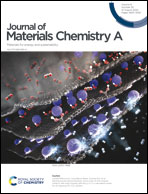Reduction of imine-based cross-linkages to achieve sustainable underwater superoleophobicity that performs under challenging conditions†
Abstract
Bio-inspired and artificial underwater superoleophobic coatings that prevent oil/oily contamination underwater have potential for diverse applications. Thus, the synthesis of highly tolerant bio-inspired underwater superoleophobic coatings is of utmost importance for achieving uninterrupted performance at practically relevant, different and challenging conditions. In the current design, both dynamic and stable cross-linkages have been exploited to obtain highly tolerant underwater superoleophobicity. Bovine serum albumin (BSA) protein was deposited following the de-solvation process, and ‘in situ’ treatment with glutaraldehyde (at pH 8) provided an imine-based cross-linked and fluorescent coating. The resultant interface displayed uninterrupted underwater superoleophobicity even after prolonged (30 days) exposure to a highly alkaline (pH 12) water, surfactant-contaminated aqueous phase, river water and sea water. However, due to accelerated hydrolysis of imine under acidic conditions, the embedded underwater superoleophobicity was completely compromised and transformed into oleophobicity with an oil contact angle of 108° on exposure to acidic conditions for 12 h. To combat this challenge, the reductive conversion of imine to secondary amine was adopted in the BSA-derived coating. The resultant coating displayed impeccable durability, and the artificial underwater superoleophobicity survived under various challenging settings, including different physical abrasions, manipulations and prolonged (30 days) exposure to acidic (pH 1) and alkaline (pH 12) aqueous phases, seawater, river water, surfactant-contaminated water, etc. Further, such a highly tolerant coating was extended to an environment friendly and efficient separation (with water collection efficiency above 98 v%) of the aqueous phase from both the refined oil and crude oil under practically relevant, diverse and challenging conditions. Thus, this simple and scalable chemical approach provided a platform for developing a highly sustainable underwater superoleophobic coating, which can perform under challenging scenarios.



 Please wait while we load your content...
Please wait while we load your content...